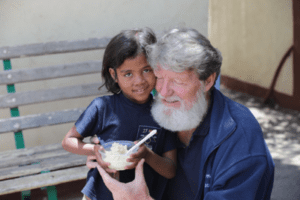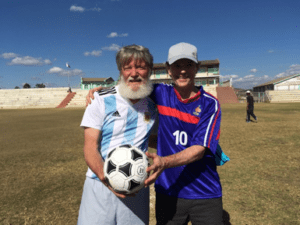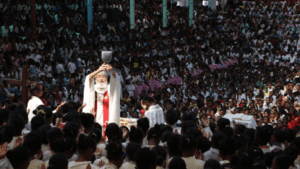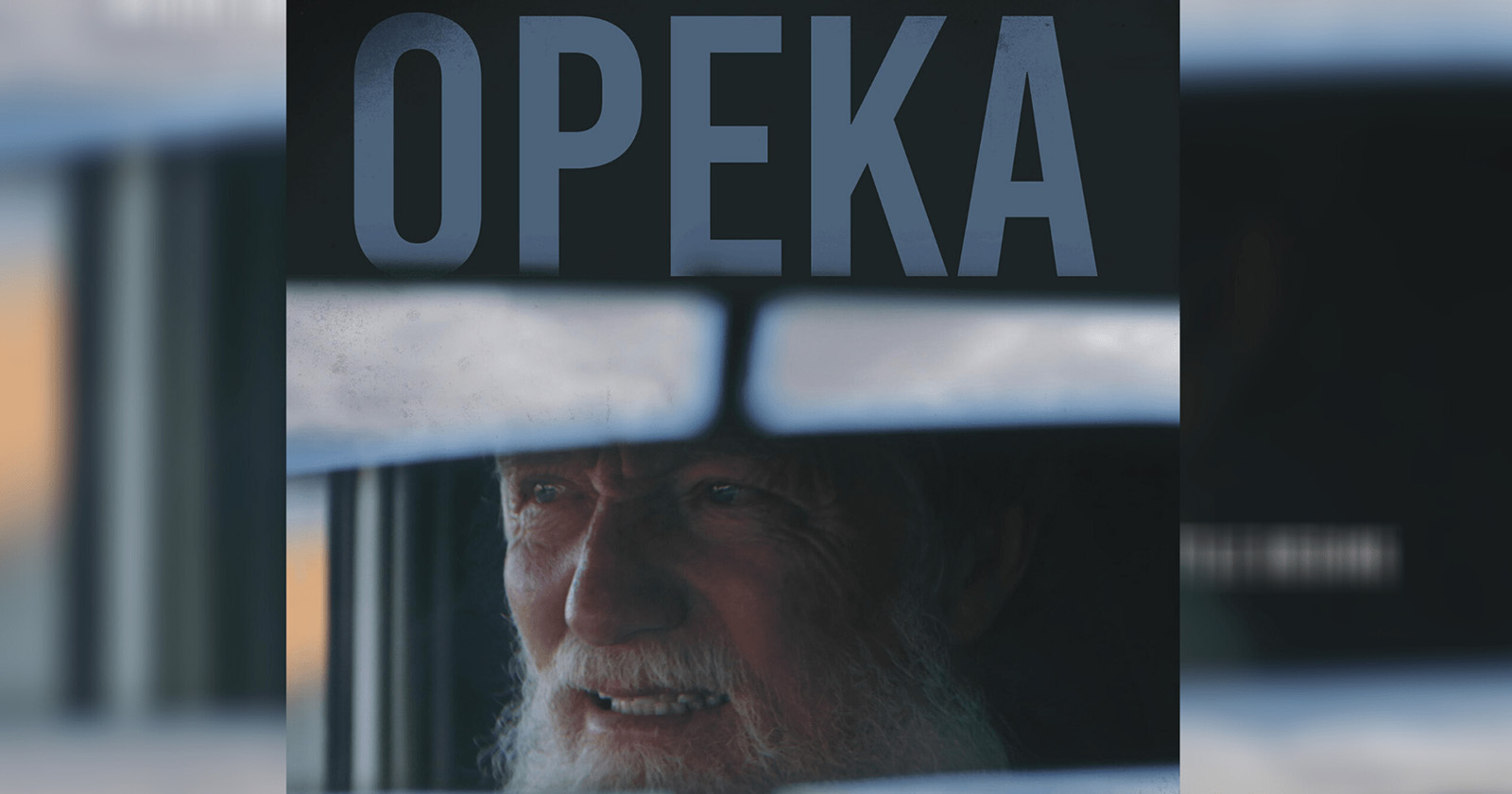Yesterday, Saturday, June 20, the winners of the prestigious Beverly Hills Film Festival were announced. The documentary “Opeka,” about the life and work of Pedro Opeka, a missionary of the Congregation of the Mission in Madagascar, has won the Golden Palm. The Beverly Hills Film Festival is considered among the most exclusive and influential film festivals globally.
The Communications Office of the Congregation of the Mission contacted Cam Cowan, director of the documentary, to interview him and to learn more about his work. The interview, which highlights the director’s passion for human rights and the fight against injustice, can be read below.
We are sure you will love this perspective on Vincentian charism!
How did you come up with the idea to make a documentary about Father Opeka?
I met Father Pedro in August 2014 while we were in production for “MADAGASIKARA,” our documentary film about Madagascar’s political, economic and social struggles. I was standing on the top ledge of a huge quarry in Antananarivo, Madagascar’s capital city, because I was interested in filming there. From below emerged a young woman carrying a basket of broken stone on her head and a baby on her back, and I asked her where people working in the quarry lived.
She said most live just outside the quarry, but “some live up there,” pointing in the distance to the next hillside. There I saw rows and rows of glistening white buildings on the hill. I had been around the entire country but had not seen so magical a scene anywhere else on the island.
I asked her what those buildings were, and she said, “That’s Akamasoa.” I then asked her what Akamasoa was, and she seemed surprised I did not know. Smiling, she said, “That’s Father Pedro!”
After doing some research on Father Pedro, I knew I wanted to interview him for the film “MADAGASIKARA.” Two months later we drove to Akamasoa and asked to see Father Pedro. He had just returned from an exhausting fund-raising trip in Europe and was very serious.
I told him I was making a film to try to bring the real Madagascar to the West. I wanted to counter the images created by Hollywood animated films and documentaries that focused on the environment and explore the lives of real people in what, at that time, was the poorest country on the planet, where 93% of the people lived on less than $2 per day, half the population of 24 million were children and half of the children were grossly malnourished.
I told him my research revealed that Madagascar had been damaged by national and international political forces – including by my own country, the U.S. – and I wanted people to understand the devasting impacts those actions had, and continued to have, on Madagascar and its people. After my explanation, with a big smile from behind his big white beard he said, “How can I help?”
During subsequent filming trips to Madagascar, Father Pedro graciously allowed me to interview him as one of the film’s experts on the conditions in the country. He appears as such briefly in “MADAGASIKARA.”
And so I got to know him better, sharing meals he insisted we eat with him, seeing him conduct Mass with thousands of Malagasy people attending – not just from Akamasoa but from everywhere in the area and from all denominations – touring the villages, meeting the people of the Akamasoa community and learning about his fascinating life story.
I soon realized that I wanted to make a documentary about Father Pedro. There have been documentaries made and books written about him, but I knew that he was not well known in much of the world, particularly North America. And I wanted to try to change that through a quality film that focused on his life and his extraordinary achievements as a humanitarian.
Why? Because he is one of the most remarkable people I have ever met. He is bigger than life. He is a force of nature who passed up an opportunity to be a professional football player in Argentina so he could dedicate his life to social justice for the poorest people on the planet. And he has demonstrated by action – audacious and overwhelming action – that poverty is not inevitable, is not fate.
I also saw that his story would be the perfect companion to “MADAGASIKARA.” That film is about survival, “OPEKA” is about hope. My intention is that the two films – as a duology – will have a poverty problem/solution impact beyond Madagascar.
How much time did you spend with Father Opeka to figure out what you want to tell and how to do it in your documentary?
I knew quickly what I wanted to tell in the film. Recently I was asked to describe Father Pedro. My response was: “Powerful. Fearless. Brilliant. Genuine.” I wanted those qualities to be revealed. I also wanted to focus on him as a humanitarian who emphasizes education, hard work, health and dignity, and who is accomplishing something extraordinary for others at great sacrifice. He knows the political leaders of Madagascar have failed their people. He not only dares to speak truth to the political elite, he backs up his words and shows them by stunning example how to alleviate extreme poverty in their country.
Importantly, too, I wanted to present him as a complete person and try to avoid indulging in hero worshipping. If there were warts, I wanted them revealed. If there were opinions he had that might ruffle feathers, I wanted them heard. He is not a superhero doing an ordinary superhero thing. He is a human being doing something truly extraordinary, and I wanted his story to inspire us all to try – just try – to help others in a meaningful way.
All of these considerations led me to the title, “OPEKA.” I didn’t want “Father Pedro” with a tag line about being a friend of the poor, or something like that. I wanted the title to be as powerful as he is and to capture the full measure of the man. A tag line can’t do that. “OPEKA” does, I believe.
How to tell the story took much more time. Much more. In a profile film such as this, often the director will rely on people who know the subject to tell much of his/her story. I wanted to do something different. I wanted the viewer to be with Father Pedro on his 50-year journey in Madagascar, and even further back to his youth in Buenos Aires. After months of collecting verité and finding archival footage, I decided the best way to be with Father Pedro on his extraordinary journey was for him to be the narrator of that journey.
And so, after he put up significant resistance, I persuaded him to let me interview him on camera to capture his full story, from his parents’ lives in post-war Slovenia to the present. We spent weeks interviewing him in his small study, in 3- and 4-hour sessions, and he truly disliked the experience. He hates talking about himself, preferring to expansively and emphatically talk about the children and poverty and politics, national and global. So, one of the things I am most proud of in our filming was being able to persuade him to keep on going with the interviews.
I also wanted to use a device of some kind that represented being with Father Pedro on this journey he narrates. And because we spent so much time with him while he drove us around Antananarivo talking, we realized during editing that driving in his truck would be the perfect “vehicle” for this. Our official poster for the film tries to capture the idea.
How did Father Opeka react when you asked him if you can make a documentary focused on his experience in Madagascar?
 He resisted at first. His life has been devoted to others, and he doesn’t like talking about himself and certainly doesn’t like talking about his private thoughts and experiences. But I believe I was able to persuade him that if we could make a quality film for a Western audience, reaching regions like North America where his work is less well known, it would be an opportunity to raise money for Akamasoa. I recall he eventually said, “If it could help the children, then I will do it.” Everything, always, to him is about helping the children.
He resisted at first. His life has been devoted to others, and he doesn’t like talking about himself and certainly doesn’t like talking about his private thoughts and experiences. But I believe I was able to persuade him that if we could make a quality film for a Western audience, reaching regions like North America where his work is less well known, it would be an opportunity to raise money for Akamasoa. I recall he eventually said, “If it could help the children, then I will do it.” Everything, always, to him is about helping the children.
Later, without Father Pedro’s knowledge, our production company – Sohei Productions – established a U.S. charitable organization dedicated to helping the children of Akamasoa: MadaKids.org. While “MADAGASIKARA” was in the 2018-19 film festival circuit, we were able to raise tens of thousands of dollars in the U.S. and send all of it to Akamasoa.
Now, with that film scheduled to be released to the public in late June, and with “OPEKA” in the 2020-21 film festival circuit, we are hoping to raise much more. There are similar organizations in many other countries that are dedicated to raising money for Akamasoa, and we hope this film will assist those efforts as well.
What were the most difficult moments of making the documentary and how did you overcome them?
 There were a few difficult moments. One, as I mentioned, was just persuading him to let us do the documentary. I had to tell him that ethically as a filmmaker I could not let him dictate what went into the film and what didn’t, that I had to make all of those decisions. I knew Father Pedro would have to take a leap of faith with me. It would be the first feature documentary of him distributed in North America, and it would probably be a film that would define his life’s story and his work creating Akamasoa. Fortunately, because of our time with Father Pedro during the filming of “MADAGASIKARA,” I believe – probably after a thorough risk /reward assessment – he decided to trust us.
There were a few difficult moments. One, as I mentioned, was just persuading him to let us do the documentary. I had to tell him that ethically as a filmmaker I could not let him dictate what went into the film and what didn’t, that I had to make all of those decisions. I knew Father Pedro would have to take a leap of faith with me. It would be the first feature documentary of him distributed in North America, and it would probably be a film that would define his life’s story and his work creating Akamasoa. Fortunately, because of our time with Father Pedro during the filming of “MADAGASIKARA,” I believe – probably after a thorough risk /reward assessment – he decided to trust us.
During filming, a difficult moment occurred in an open market area in Akamasoa. We were filming Father Pedro as he walked through the market talking with people, and suddenly he was accosted by a drunk woman. It was terribly unsettling to the crew, and the people in the market seemed to be getting out of control, but Father Pedro handled the conflict with compassion and restraint. That moment is captured in our film.
The most difficult moments, though, were witnessing what Father Pedro witnesses every day. It was hard for us to be walking with him through the city landfill next to Akamasoa, as the acrid smoke from burning garbage enveloped us and assaulted our senses. We observed people – families – mostly barefoot digging for clothing and bits of plastic and metal to sell.
It was also difficult to see the frequent funerals he officiated, particularly of the young. Father Pedro knows that his work is not yet done.
However, these difficult moments were overwhelmed by the joyful moments we experienced every day. Akamasoa is, in a way, an oasis in an impoverished land, and it was a privilege being a witness to the natural joy in the faces of the children there and the expectation they have for an educated and healthy life.
What has this experience of filming Father Opeka’s ministry brought to you as a director and as a man?
 As a director, I knew there would be a potential tension between my wanting to make an honest film and having such great admiration for Father Pedro, and I had to keep reminding myself of my mission. It is difficult to be in his presence and not be enthralled, and it is difficult to bear witness to what he has accomplished and not be in awe. I tried not to glorify him and his work and to capture him as a full human being. I hope I have accomplished that. I suspect there are moments in the film that Father Pedro doesn’t like or wishes were not included, and if so, then I probably succeeded. In this process, because I was tested, I believe I became even more committed to honest story telling through film.
As a director, I knew there would be a potential tension between my wanting to make an honest film and having such great admiration for Father Pedro, and I had to keep reminding myself of my mission. It is difficult to be in his presence and not be enthralled, and it is difficult to bear witness to what he has accomplished and not be in awe. I tried not to glorify him and his work and to capture him as a full human being. I hope I have accomplished that. I suspect there are moments in the film that Father Pedro doesn’t like or wishes were not included, and if so, then I probably succeeded. In this process, because I was tested, I believe I became even more committed to honest story telling through film.
As a man, well, that is personally more difficult to express. Like Father Pedro, I resist revealing private feelings, but I’ll give it a try. I can say that I am not a religiously devout person. I was focused on Father Pedro as a humanitarian, not as a Catholic missionary. He once asked me at lunch if I prayed, and I told him I did not. He then conjectured that I probably prayed in my own way. I think I responded with something inane about spirituality. I will say this: being in his presence and feeling his passion for justice, witnessing how hard he fights for his “brothers and sisters,” hearing about his deep and unwavering faith, and witnessing the collective power created from his epic Masses, I probably came as close to God’s energy as someone like me can.
Can you share with us an anecdote regarding the documentary, something the camera did not show and that you would like to share with the audience from our Congregation?
In late 2015, Father Pedro came to the U.S. to receive the Spirit of Service Award from St. John’s University. My wife and I attended the awards dinner, and a couple of days later I visited Father Pedro while he was staying on the St. John’s campus. We went on a tour of the campus, and when we got to the varsity soccer field, he was asked by one of the guides, knowing Father Pedro’s background, if he would like to kick a few goals.
The field was made of artificial turf, and that appeared to be the first time he had been on that surface. He took off his shoes and started to do some warmup exercises while the guide went to fetch a soccer ball. When he returned, Father Pedro said to me, “Cam, you go in the goal.” He and I had already developed a competitive banter, so of course I said I would. I had played soccer in my youth and felt I could keep him from scoring.
He placed the ball on the outside of the penalty box – 18 yards from the goal. He looked up at me and said, “Cam, I am sorry. I am sorry.” He then began to fire the ball at me with his feet. Either foot, left or right, the balls kept coming at me at intense speeds. And students in the area began to gather around and watch, because they heard the crack of his stocking feet hitting the ball and saw a man in a gray suit with a mane of white hair and a big white beard doing the kicking. I was able to keep most of the balls out of the goal, but my ungloved hands were on fire from the power of his kicks.
He then took a short break, put the ball back on the outside of the penalty box. He again said, “Cam, I am sorry. I am sorry.” He then started to loft the balls in a perfect arc over my outstretched hands and into the goal, almost every time and to the applause of the crowd.
In late 2019, I wanted to capture him on film kicking goals at Akamasoa. So, I challenged him to a repeat of that day at St. John’s. The result was about the same, except this time, even with goalkeeper gloves on, I came away with a damaged left finger that took weeks to heal.
I like this personal anecdote because it reveals Father Pedro as highly competitive, still very athletic, and always fun-loving and playful, traits which might escape notice in the film.
In our film, Father Pedro makes reference to the St. John’s field. I won’t spoil the scene by saying more. Also, in the trailer and the film, we have clips of Father Pedro kicking goals that day in 2019 in his Argentina football jersey.
We are thinking about your previous documentary MADAGASIKARA, now. In that production, you paid special attention to the rights of the marginalized, to the struggle to claim these rights and above all to the hope. How are you dealing with these issues in OPEKA?
 In “MADAGASIKARA,” we follow the lives of three strong Malagasy women and their families, as representatives of 90% of the population of the country struggling to survive. It is an uncomfortable film to watch for many, because we were trying to present the “real” Madagascar and not an artificially constructed story with a third-act happy resolution. A recent review of the film commented that, “The film is decidedly free of crafted exposition or images designed to spur some exploitive emotion. This is the reality, a stark, unfiltered observation that shows a people who find and define in the darkest times what it means to be human when so much of what most take for granted is stripped away.” (David Duprey, That Moment In, May 24, 2020)
In “MADAGASIKARA,” we follow the lives of three strong Malagasy women and their families, as representatives of 90% of the population of the country struggling to survive. It is an uncomfortable film to watch for many, because we were trying to present the “real” Madagascar and not an artificially constructed story with a third-act happy resolution. A recent review of the film commented that, “The film is decidedly free of crafted exposition or images designed to spur some exploitive emotion. This is the reality, a stark, unfiltered observation that shows a people who find and define in the darkest times what it means to be human when so much of what most take for granted is stripped away.” (David Duprey, That Moment In, May 24, 2020)
Their perseverance, resilience and dedication to their children in the face of seemingly insurmountable obstacles is the hope conveyed in the film: “These are not helpless women, not unintelligent, and not seeking pity. They have carved out what would seem impossible fortitude in a time and place where futility seems borne from every moment.”
 In “OPEKA,” there is a critique about the government’s failure to address the extreme poverty in the country and to provide the population with adequate food, water, shelter, health and education. But most of the film is about action – concrete action – taken by a man to restore those rights where the government has failed.
In “OPEKA,” there is a critique about the government’s failure to address the extreme poverty in the country and to provide the population with adequate food, water, shelter, health and education. But most of the film is about action – concrete action – taken by a man to restore those rights where the government has failed.
At a social level, we want this story to convey that extreme poverty is not inevitable. We want our audience to see that out of the worst possible conditions – a deadly landfill site – a shining city on the hill can rise up and provide hope and dignity and become the source of educated and empowered children who might one day save their own country.
At an individual level, we want this story to inspire each of us – anywhere in the world – to try to be better. Pedro Opeka’s example is powerful. His life’s theme, in his words that “justice must be the basis of all our actions,” is instructive and illuminating. But it is the power of his will to do justice that we hope we have conveyed. The power of his will can inspire us all.
Source: https://cmglobal.org/









0 Comments